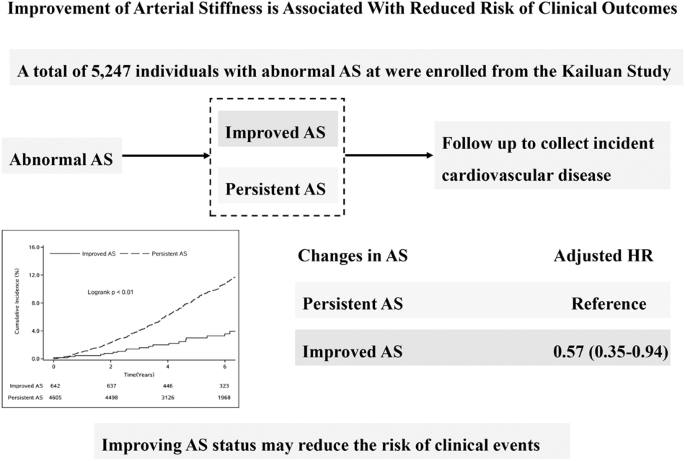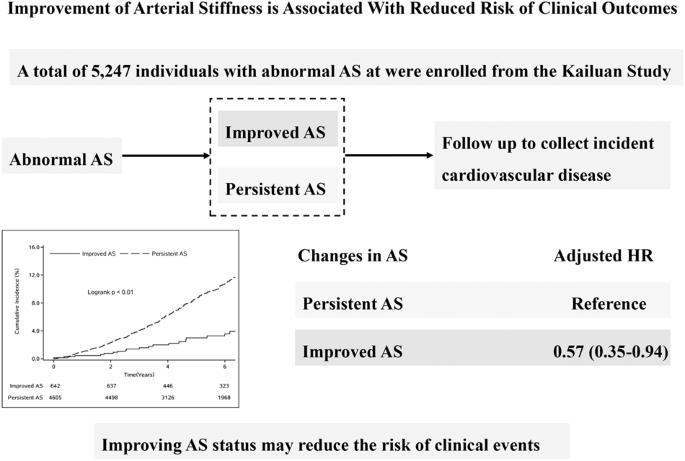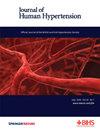baPWV的变化与临床结局风险:一项针对中国社区人群的队列研究
IF 3.4
4区 医学
Q2 PERIPHERAL VASCULAR DISEASE
引用次数: 0
摘要
在以社区为基础的人群研究中,改善动脉僵化(AS)是否能降低临床结果风险尚未得到充分研究。在这项前瞻性研究中,开滦研究共纳入了 5247 名 AS 异常(基线时)且在 2018 年前重复测量过肱-踝脉搏波速度(baPWV)的个体。根据第二次baPWV测量结果,我们将参与者分为两组,即强直性脊柱炎改善组(定义为强直性脊柱炎升高状态转为正常)和强直性脊柱炎持续组(定义为强直性脊柱炎升高状态维持不变)。结果是中风、心肌梗死和全因死亡的综合事件。我们使用 Cox 比例危险回归法来检验随访时的 AS 状态与后续结果之间的关联。在中位 5.2 年的随访期间,我们观察到 413 例终点事件。在对潜在的混杂因素进行调整后,与持续性强直性脊柱炎组相比,强直性脊柱炎好转组的患者发生主要复合事件的风险降低了 43%(危险比 [HR],0.57;95% 置信区间 [CI],0.35-0.94)。我们还发现,baPWV 下降 1 m/s 与主要复合事件风险降低 3% 相关(HR,0.97;95% 置信区间 [CI],0.94-0.99)。我们进一步证实,年龄小于 60 岁、不吸烟、无高血压、无糖尿病与改善 AS 状态有关。总之,改善强直性脊柱炎状况可降低发生临床事件的风险。今后,应开展更多的研究来探索改善 AS 状态的目标。本文章由计算机程序翻译,如有差异,请以英文原文为准。


Changes in baPWV and the risk of clinical outcomes: a cohort study of Chinese community-based population
It has not been fully investigated whether improved arterial stiffness (AS) can reduce the clinical outcomes risk in community population-based study. In this prospective study, a total of 5247 individuals with abnormal AS (at baseline) and repeated brachial-ankle pulse wave velocity (baPWV) measurement before 2018 years were enrolled from the Kailuan Study. According the second baPWV measurement, we divided the participants into two groups, improved AS (defined as transfer elevated AS status to normal) and persistent AS (defined as maintaining elevated AS status). The outcome was a composite event of stroke, myocardial infraction, and all-cause mortality. We used Cox proportional hazards regression to examine the association between AS status at the follow-up and the subsequent outcome. During a median of 5.2 years follow-up, we observed 413 end point events. After adjusted for potential confounders, comparing with the persistent AS group, individuals in the improved AS group had a 43% (hazard ratio [HR], 0.57; 95% confidence interval [CI] 0.35–0.94) decreased the risk of the primary composite events. We also found a baPWV decrease of 1 m/s was associated with a 3% decreased risk (HR, 0.97; 95% CI 0.94–0.99) for primary composite events. We further demonstrated that younger than 60 years, non-smoker, non-hypertension, and non-diabetes were associated with improved the AS status. In conclusion, improving AS status may reduce the risk of clinical events. In the future, more research should be performed to explore the target for improving the AS status.
求助全文
通过发布文献求助,成功后即可免费获取论文全文。
去求助
来源期刊

Journal of Human Hypertension
医学-外周血管病
CiteScore
5.20
自引率
3.70%
发文量
126
审稿时长
6-12 weeks
期刊介绍:
Journal of Human Hypertension is published monthly and is of interest to health care professionals who deal with hypertension (specialists, internists, primary care physicians) and public health workers. We believe that our patients benefit from robust scientific data that are based on well conducted clinical trials. We also believe that basic sciences are the foundations on which we build our knowledge of clinical conditions and their management. Towards this end, although we are primarily a clinical based journal, we also welcome suitable basic sciences studies that promote our understanding of human hypertension.
The journal aims to perform the dual role of increasing knowledge in the field of high blood pressure as well as improving the standard of care of patients. The editors will consider for publication all suitable papers dealing directly or indirectly with clinical aspects of hypertension, including but not limited to epidemiology, pathophysiology, therapeutics and basic sciences involving human subjects or tissues. We also consider papers from all specialties such as ophthalmology, cardiology, nephrology, obstetrics and stroke medicine that deal with the various aspects of hypertension and its complications.
 求助内容:
求助内容: 应助结果提醒方式:
应助结果提醒方式:


